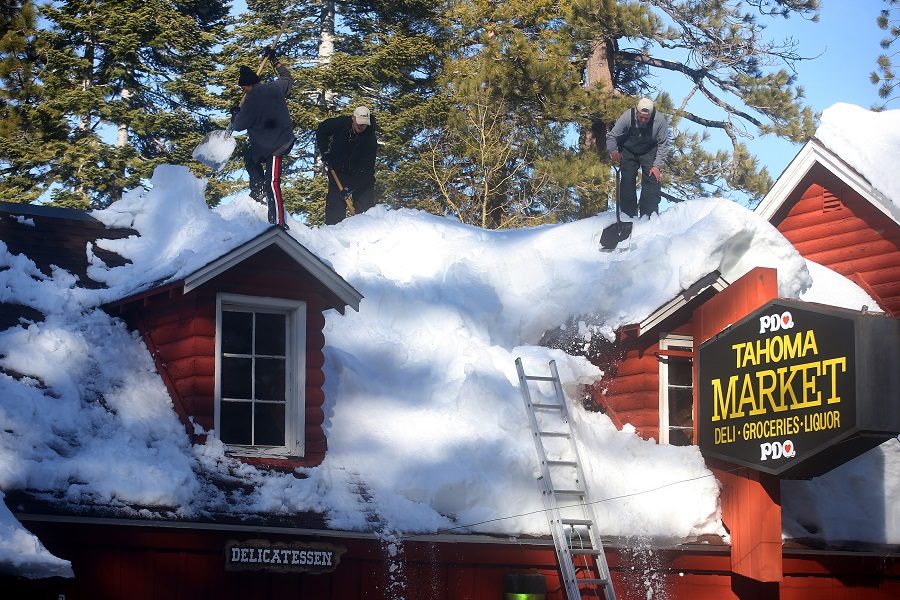
The last time there was this much snow on Feb. 1 in the Sierra was in 1995. Pete Wilson was California's governor, "Seinfeld" was the top-rated show on television and Steve Young had just led the 49ers to a blowout win in Super Bowl XXIX.
In a breathtaking shift for a state that had been mired in five years of punishing drought, 25 feet of new snow has fallen on Heavenly ski resort in South Lake Tahoe since New Year's Day. Freeways and schools across the Sierra have been closed at times, and firefighters are having trouble finding fire hydrants.
"Some are buried under 12 or 13 feet of snow," said Eric Guevin, fire marshal at the Tahoe-Douglas Fire Protection District in Zephyr Cove, Nevada, just north of the California state line. "We've had to use metal detectors to find them."
After a week to dry off, a new round of storms is set to roll into California. A Pacific system will dump up to 3 more feet of new snow in the Sierra by this weekend.
"It's a solid storm, not quite as big as some earlier this month, but it will still bring a decent amount of snow," said Tony Fuentes, a meteorologist with the National Weather Service in Reno.
On Thursday, officials with the state Department of Water Resources are scheduled to escort reporters up to a Phillips Station, a meadow off Highway 50 near Lake Tahoe, for the monthly manual snowpack reading. The event is largely a photo opportunity that measures only one site.
But daily readings from more than 100 electronic sensors across the famed Sierra range, which stretches 400 miles from Lassen County to the Tehachapi Pass in Kern County, show that the water content in California's vast "frozen reservoir" is already 108 percent of the April 1 historic average, with another two months still to go in the winter.
On Jan. 1, it was just 64 percent of the historic average for that date, and 23 percent of the April 1 average.
"We've had a tremendous increase in rainfall and snowfall so far this season," said Doug Carlson, a spokesman for the state Department of Water Resources. "It's way up there compared to a month ago."
State officials are still urging caution, however, and say that Gov. Jerry Brown isn't likely to make a decision on whether to amend or rescind the state's emergency drought declaration from January 2014 until April, when the full winter season is over. After his administration eased state drought regulations last summer, most cities dropped surcharges, fines and lawn watering limits.
"We're hoping people don't get carried away by these figures and fail to recognize how quickly things can change," Carlson said. "They can change on a dime. We are still encouraging people to be water conscious and consider water conservation to be a California way of life."
The U.S. Drought Monitor, a weekly report put out by federal officials, reported last Thursday that 49 percent of California is no longer a drought, including every Northern California county from the Bay Area and Lake Tahoe to the Oregon border, although significant parts of Southern California and the San Joaquin Valley remain in drought.
The storms have filled reservoirs around the state. And as the year progresses and the snow melts, the runoff will send billions of gallons of additional water into rivers, streams, groundwater tables and reservoirs.
The snow also has been a bounty for Sierra ski resorts, which struggled mightily during the worst part of the drought. On Feb. 1, 2014, for example, the statewide Sierra snowpack was just 9 percent of the historic average, the lowest ever measured at that time of year — and even worse than the dismal 1976-77 drought, when it hovered in the mid-20s.
"It looks like we are headed into a record-breaking season and will be skiing well into July," said Lauren Burke, a spokeswoman for Mammoth Mountain Ski Resort in Mammoth Lakes.
At 177 percent of average now, the Sierra snowpack is the biggest since it reached 207 percent on Feb. 1, 1995, according to state records. Since 1950, that year was the third largest snowpack, behind 1952, when it was 267 percent and 1969, when it was 230 percent, on Feb. 1.
This year, the Sierra snowpack so far ranks seventh.
Although water managers and resorts are celebrating, there have been hardships. Last week, Squaw Valley ski patrol member Joe Zuiches was killed while working to reduce avalanche risk with ammonium nitrate charges. Zuiches, 42, was an emergency medical technician and experienced mountaineer who was originally from Washington state. He died when a hand charge he was carrying exploded prematurely.
In January, Interstate 80 and Highway 50 were closed multiple times, stranding thousands of motorists, and the snow was so overwhelming at times that major ski resorts closed for several days.
"After going through five years of drought and low snowpack, initially people up here were really excited and enthused," said Fuentes, of the National Weather Service. "We really need the water. But after a point, people started to get a little tired of it and wanted a break. It's kind of a mixed bag. There can be too much of a good thing."




Reader Comments
to our Newsletter